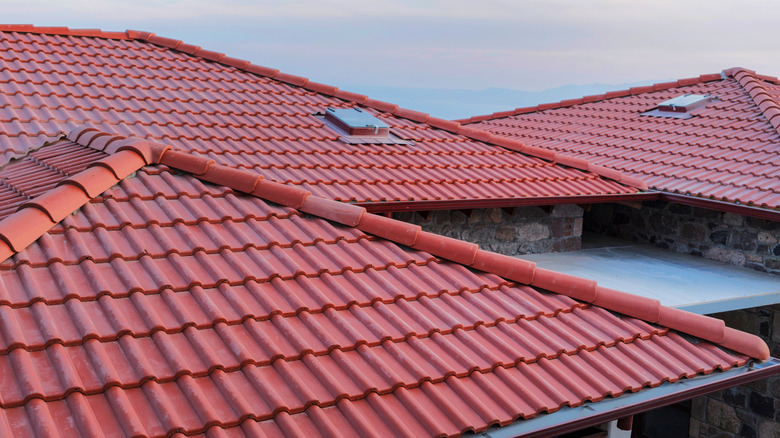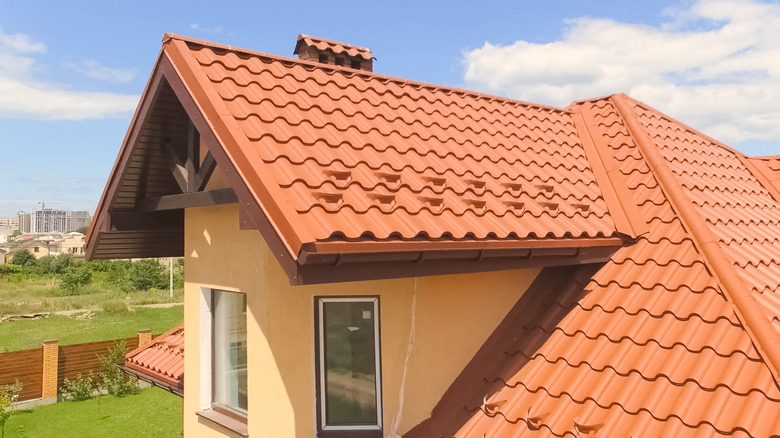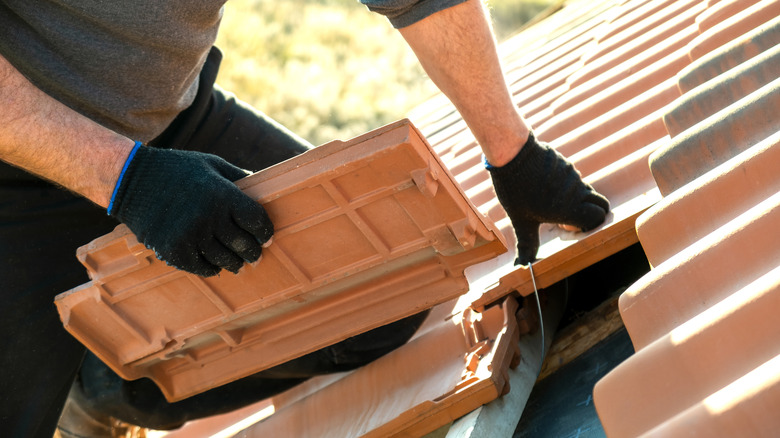The Statement Roof Material That Makes Hacienda Architecture Unique
Many architectural styles have a few signature details that are characteristic of a particular style and that an architecture enthusiast will instantaneously recognize. In some cases, it's a series of decorative embellishments, a particular material or color palette, or even shapes, patterns, or finishes that become synonymous with the style. Hacienda architecture has several key details fans of the style might recognize, including exterior archways, exposed wood beams, and adobe walls. However, the most distinctive and visually apparent are the signature red clay roof tiles. Everything from the unique curved shape to the earthy hue to the unique material gives hacienda-style homes a certain curb appeal.
Since hacienda-style homes are popular in warm-weather climates, these signature tiles actually serve a purpose beyond aesthetics. The combination of the clay material's properties as well as the unique curved shape gives the tiles the ability to keep a house cooler than the standard flat asphalt shingles found on many homes. If you're looking to give your home a little hacienda inspiration, you do want to consider the overall exterior aesthetic of your space and whether red clay roof tiles would make a cohesive addition. However, if you think swapping out your roofing is exactly what your home needs to make you feel like you're on a warm-weather vacation, you'll want to consider some of the benefits and downsides before you take the plunge.
Benefits of red clay roof tiles
Apart from embracing the hacienda architecture style, there are a lot of pros to opting for red clay roof tiles. One of the biggest benefits is that they're extremely durable. This is a particular plus if you live in an area with extreme weather or where natural disasters are somewhat common. Thanks to the material they're made of, red clay roof tiles are naturally very fire-resistant, impact-resistant, and wind resistant. And, they won't be affected by rot or damage from insects, as some other natural materials like wood are.
Partially due to that durability, they also have a very long life span (we're talking 70 years or more). This means that if you make the investment once, you likely won't have to worry much about the roof of your home for the rest of your life. Finally, as you might assume given that they're crafted from clay, a natural material, they're also an environmentally friendly choice, which eco-conscious homeowners will love — they can even be recycled if you change your mind one day and they're no longer needed. Red clay roof tiles are also incredibly energy efficient, helping to keep your home cool when it's hot outside and warm when it's cold outside.
Downsides of red clay roof tiles
Before you get too convinced by the benefits of red clay tiles and their stunning aesthetic, you do still want to take the time to consider some of the characteristics that make them challenging to work with. First of all, that much-lauded durability comes at a cost. They're relatively expensive when compared to many other roofing materials, so may not be the right choice for budget-friendly renovators. And, while only the boldest DIY-er would consider switching out their own roofing no matter the material, clay tiles are particularly difficult to install. This means you'll definitely have to bring in the pros, which will further add to the overall price tag.
Additionally, you need to ensure your home is a good fit for this type of roofing, as that isn't always the case. They're quite heavy, which may become a factor if you're swapping out a lighter type of tile such as wood or asphalt shingles. Just to be on the safe side, you'll want to ensure your home's structure can bear that additional weight (or you'll need to find ways to reinforce it so that it can). And, you'll also have to consider the particular slope of your roof, something that's quite difficult to change unless you're doing a massive renovation. That's because, for red clay tiles, your roof has to be within particular parameters, not too steep but not too flat.


